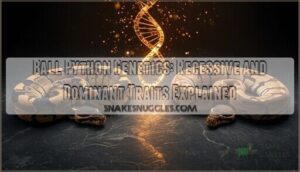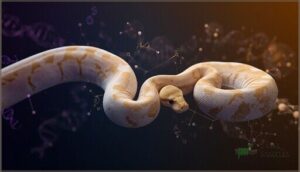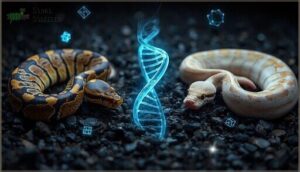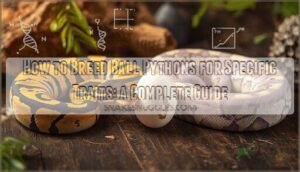This site is supported by our readers. We may earn a commission, at no cost to you, if you purchase through links.

You pair two ball pythons expecting one thing, and the babies look completely different. That’s ball python genetics recessive and dominant traits at work. Some morphs show up with just one copy of a gene, while others hide until two copies meet.
The difference between dominant, co-dominant, and recessive inheritance determines which colors and patterns appear in your clutch. Understanding how these traits pass from parent to offspring takes the guesswork out of breeding.
Once you know which genes need one copy versus two, you can predict outcomes with real accuracy and plan pairings that produce the morphs you’re after.
Table Of Contents
Key Takeaways
- Dominant genes express with just one copy (like Spider or Pinstripe), while recessive traits need two copies to show visually (like Albino or Piebald), making dominant morphs faster to produce but recessive combos more valuable due to rarity.
- Co-dominant morphs create a visual change with one copy and an intensified “super” form with two copies (such as Super Pastel), offering breeders both immediate results and enhanced breeding potential in the same genetic line.
- Heterozygous (“het”) ball pythons carry hidden recessive traits without showing them, requiring breeding trials or DNA testing to confirm genetics—pairing two hets yields only 25% visual offspring and 50% het carriers.
- Responsible breeding means avoiding morphs with known health issues (like Spider Wobble or Super Cinnamon eye defects), tracking bloodlines to maintain genetic diversity, and balancing market trends with animal welfare rather than chasing profits alone.
Key Genetic Terms in Ball Pythons
Before you can predict what your baby ball pythons will look like, you need to speak the language of genetics. A few key terms make the difference between confusion and clarity when you’re planning breeding projects.
Let’s break down the essential vocabulary that every breeder uses to describe how traits pass from parents to offspring.
Genes, Alleles, and Mutations
Your ball python’s appearance starts with genes—segments of DNA that control traits like color and pattern. Each gene comes in different versions called alleles, one inherited from each parent.
When a mutation occurs, it creates a new allele that changes how your snake looks. These mutations can be recessive, needing two copies to show, or dominant, expressing with just one.
Some genes, known as allelic genes, meet at the same locus, creating a genetic mutation.
Dominant, Recessive, and Co-Dominant Traits
Understanding how different allele interactions work changes everything about predicting breeding outcomes. Dominant genes need just one copy to show up visually—think Spider or Pinstripe. Recessive traits like Albino require two copies, one from each parent. Codominant genes are where things get interesting: they create visual expression with one copy and an enhanced “super” form with two. A single female with a co-dominant morph can be the source of many genetic firsts, making them valuable for breeding.
- Dominant traits appear with a single mutated allele
- Recessive traits need both alleles mutated to express visually
- Codominant genes show distinct patterns in both het and homozygous forms
- Genetic inheritance patterns determine your morph combinations and genetic diversity
Visual Vs. Heterozygous Expression
When you look at your snake, you’re seeing its phenotype—the visual result of its genes. Visual morphs like Albino or Pied show that recessive trait because both alleles match. Het snakes carry one copy but look normal, making visual identification impossible without molecular confirmation through DNA testing.
That’s where breeding outcomes reveal hidden genetics. Dominant morphs skip this guessing game—phenotype variation appears immediately, no het discrimination needed.
Dominant and Co-Dominant Gene Inheritance
Dominant and co-dominant genes work differently than recessive ones because you only need one copy to see results. That single gene can create a visible morph, and in some cases, breeding two copies together produces an even more striking “super” form.
Let’s look at how these traits pass from parents to offspring and which morphs fall into these categories.
How Dominant Traits Are Passed Down
When you breed a dominant morph like Pinstripe with a normal ball python, you’ll get roughly 50% visual offspring—that’s Mendelian ratios in action. Dominant genes guarantee visual expression with just one copy, making breeding predictability straightforward.
- Each egg has a 50% chance of inheriting the dominant trait
- Dominant inheritance means no hidden “het” carriers exist
- Homozygous traits look identical to heterozygous ones—no super form
- Genetic trait transmission occurs reliably every generation
Co-Dominant and “Super” Forms
Co-dominant morphs—also called incomplete dominant traits—show up visually with just one allele, but here’s where it gets exciting: breeding two together produces a super form with intensified visual characteristics.
Your Super Pastel or Super Banana displays enhanced phenotype expression through homozygous allelic combinations. The genetic expression creates distinct pattern changes and color amplification, making these breeding super forms highly sought after for their striking visual intensification.
Common Dominant and Co-Dominant Morphs
You’ll encounter these powerhouse genes repeatedly in breeding programs:
- Spider Genetics – The most widespread dominant morph, with over 20,000 specimens on MorphMarket, though breeding advantages come with caution due to lethal super forms.
- Pastel Variations – Brightens colors as a codominant gene; visual appeal doubles in Super Pastel form.
- Mojave Complex – Creates the stunning Blue-Eyed Leucistic when bred homozygously.
- Clown Inheritance – Sharp tan markings pass reliably through generations.
- Combined morphs like Bumblebee (Pastel × Spider) drive market demand through stacked Ball Python genes.
Recessive Gene Inheritance in Ball Pythons
Recessive traits work differently than dominant ones—they stay hidden unless both parents pass down the same gene. This is where things get interesting for breeders, because you can carry these traits without seeing them.
Let’s break down how recessive genes move through generations and what that means for your breeding projects.
How Recessive Traits Are Inherited
Recessive traits in ball pythons only appear when the snake inherits two copies of the same gene—one from each parent. This is similar to needing both keys to open a door. This phenomenon is known as Mendelian ratios in action, where the parental contribution determines the visible traits. If a snake carries just one copy of the gene, it is considered heterozygous, meaning it holds the trait invisibly.
| Breeding Pair | Visual Offspring | Het Offspring | Normal Offspring | Probability Notes |
|---|---|---|---|---|
| Het × Het | 25% | 50% | 25% | Standard recessive gene inheritance pattern |
| Visual × Het | 50% | 50% | 0% | All carry at least one copy |
| Visual × Visual | 100% | 0% | 0% | Guaranteed recessive traits expressed |
| Normal × Visual | 0% | 100% | 0% | Het identification requires breeding trials |
| Double Het × Double Het | 6.25% (both traits) | Variable | Reduced | Multi-recessive traits exponentially decrease odds |
Heterozygous (“Het”) Ball Pythons
Think of het ball pythons as genetic sleeper agents—they carry a recessive trait invisibly, looking just like normal wild types. Phenotypic challenges make Het Identification nearly impossible without breeding trials or molecular tests like PCR.
Het ball pythons are genetic sleeper agents—they carry recessive traits invisibly, undetectable without breeding trials or molecular testing
Here’s what matters for your Morph Development strategy:
- Breeding Strategies rely on probabilities: het × normal yields 50% het offspring
- Statistical Measures show 66% of normal-looking snakes from het × het pairings are actually hets
- Ball Python genetics demands patience—you won’t see the recessive trait until you pair two carriers together
Double and Multi-Recessive Morphs
When you’re chasing double recessive morphs like Albino Piebald, you’re playing the long game. Your ball python needs two copies of each recessive trait—homozygous for both genes—to show visually. Double Het Breeding delivers that magic combo in just 1 out of 16 offspring. Multi-Gene Complexity escalates fast: tracking three recessive traits? You’re looking at 1 in 64 odds.
| Breeding Outcome | Probability (%) |
|---|---|
| Double recessive visual | 6.25 |
| Single recessive visual | 18.75 |
| Heterozygous carriers | 56.25 |
| Normal (non-carrier) | 18.75 |
Genetic inheritance follows strict Mendelian patterns, but breeding challenges mount quickly. Statistical outcomes show most offspring won’t express both recessive traits visually—patience and genetic tracking become non-negotiable. That rarity and value? It’s earned through generations of strategic pairings.
Examples of Popular Recessive Morphs
You’ve probably seen the classics that make recessive breeding worth the wait. These morphs need two copies to shine, and each brings something unique to your collection:
- Albino variations transform your snake into vibrant yellows and whites—breeding two albinos guarantees 100% albino offspring, while pairing with normals produces all het carriers.
- Piebald patterns create striking white patches mixed with color—found in 1-5% of captive populations, these visual stunners emerge from homozygous pairings.
- Axanthic combos strip away yellows for pure silver elegance, commanding over $3,000 for their monochromatic appeal.
Butter maturation takes 2-3 years before breeding, but those creamy tones pair beautifully in designer combos. Mojave combos deliver high-contrast drama that’s become a breeding staple.
Understanding which morphs are recessive—and tracking your hets—turns patient genetics into profitable reality.
Predicting Offspring Traits and Morphs
Once you understand how genes work, the next step is figuring out what you’ll actually get from a pairing. This is where Punnett squares and breeding strategies come in—they help you map out the odds before you ever put two snakes together.
Let’s break down how to predict morphs and plan your breeding projects with confidence.
Using Punnett Squares for Ball Pythons
A Punnett Square maps out allele combinations from two parents, showing you every possible outcome before you pair your snakes. When you cross two het albinos, you’ll see that classic Mendelian ratio: 25% normal, 50% het, and 25% visual albino.
This tool helps predict morph probabilities for dominant, recessive, and even double recessives, though remember its prediction limitations with small clutch sizes.
Genotype and Phenotype Predictions
Genotype accuracy exceeds 95% when you work from confirmed genetic tests, but phenotype variation reminds you that expression isn’t always straightforward.
Your Punnett Squares nail trait probability for single genes—75% when crossing two hets for recessive traits—yet predicting morphs gets trickier with co-dominants and multi-gene combos.
Breeding outcomes depend on understanding both genotype certainty and phenotype surprises.
Breeding Strategies for Desired Morphs
Once you’ve mapped probabilities, the real work begins: choosing pairs that deliver the morphs you want. Ball Python genetics reward smart strategy. Dominant advantages shine in fast visual results, while recessive challenges demand patience and careful het tracking. Genetic compatibility matters—mismatched goals waste clutches. Here’s how to improve offspring outcomes:
- Start with dominant or co-dominant morphs for quicker visual payoff in your breeding program
- Track heterozygous status religiously when working recessive traits—pedigree records prevent costly surprises
- Combine morph combinations strategically to layer traits without sacrificing genetic diversity
- Breed proven pairs repeatedly to establish consistency before experimenting with complex multi-gene projects
- Balance market demand with ethical considerations—popular morphs shouldn’t compromise animal health
Ethical and Practical Breeding Considerations
Breeding ball pythons isn’t just about pairing morphs to get flashy offspring—it’s about doing it responsibly. You need to watch for genetic health risks, keep track of bloodlines, and make smart choices about which morphs you work with.
Let’s look at the key considerations that separate thoughtful breeders from those who cut corners.
Avoiding Health Issues Linked to Genetics
Not all morphs are created equal in terms of health. Spider Wobble causes neurological issues like balance problems, while Eye Defects appear in Super Cinnamon and Super Black Pastel. You’ll want to avoid pairing morphs that produce severe Morph Risks.
Breeding Ethics means choosing Genetic Diversity over profits—outcrossing to unrelated lines reduces both recessive and dominant genetic issues.
Tracking Lineage and Genetic Diversity
When you track bloodlines with lineage software, you’re building pedigree accuracy that strengthens your entire breeding program. Selective breeding strategies rely on knowing inheritance patterns across generations, which boosts morph stability and reduces introgression risks. About 75% of pros keep detailed records to prevent inbreeding and maintain genetic diversity. Without that data, you’re guessing—and genetic diversity suffers.
Responsible Morph Selection and Market Trends
When you choose morphs thoughtfully, you’re not just chasing trends—you’re protecting your investment and your animals’ welfare. Market saturation impact has driven common morph prices down 25% since 2023, while ethical breeding influence shapes buyer preferences. Ball Python genetics requires balancing profit with responsibility.
- Beginner-friendly morphs now make up 45% of sales, showing clear market direction
- Selective breeding for genetic health issues prevention cuts losses by 20%
- Price volatility risks affect rare combos with 10-15% monthly swings
- Ethical pairings command 35% premiums as consumers prioritize genetic diversity and morph health ethics
Frequently Asked Questions (FAQs)
Can two normal ball pythons produce morphs?
Can two normals really surprise you? Yes, if both carry hidden het gene carriers.
Breeding outcome predictions show recessive trait expression occurs when compatible genes combine, creating a 25% visual morph probability from their genetic combination outcomes.
How do incomplete dominant genes differ exactly?
Incomplete dominant genes create a blending effect—heterozygous phenotypes show intermediate traits, while homozygous expression produces “super” forms.
Visual differences distinguish them from codominance, dominant, and recessive inheritance patterns in ball python genetics breeding outcomes.
What happens when breeding incompatible morph combinations?
Breeding mismatched morphs is like rolling dice with loaded odds. Genetic traits clash, causing deformity risks, wobble syndrome, fertility issues, and lethal genes.
Dominant and recessive incompatibilities raise serious ethical concerns in ball python genetics and breeding.
Do all morphs have the same lifespan?
Most ball python morphs share similar lifespans of 20-30 years with proper care. However, genetic health impact from certain morphs like Spider can reduce longevity.
Captive care effects matter more than morph type overall.
How often do spontaneous mutations occur naturally?
Spontaneous genetic mutations are like lightning strikes in the genome—rare but powerful. They occur at roughly 17 × 10⁻⁸ per generation per nucleotide site, quietly fueling novel morphs and genetic diversity while most traits remain inherited.
Conclusion
Breeding ball pythons isn’t a coin flip—it’s a blueprint you can read once you understand the rules. Ball python genetics—recessive and dominant traits—give you control over which morphs emerge, turning chance into strategy.
Track your hets, pair your genes with intention, and every clutch becomes less of a surprise and more of a plan. The difference between guessing and knowing comes down to one thing: recognizing which traits need one copy to shine and which need two.
- https://research.uga.edu/news/crispr-provides-new-understanding-of-reptile-coloration/
- https://royalconstrictordesigns.com/ball-python-genetics
- https://community.morphmarket.com/t/genetics-morphs/4809
- http://www.worldofballpythons.com/morphs?q=daddy
- https://www.xyzreptiles.com/breeding-codom-morphs-versus-recessive-ball-python-morphs/












